Building a Mining Operation in Your HO Scale Layout
Building a Mining Operation in Your HO Scale Layout
Building a Mining Operation in Your HO Scale Layout: Delve into Industrial Rails!
Howdy, fellow train enthusiasts! Today, we’re going on a journey to bring the gritty realism of a working mining operation right onto your HO scale layout. Imagine it â ore trains rumbling along, dust plumes swirling in the air, and industrious workers bustling about. That’s the magic of incorporating an industrial sector into your miniature world!
For those new to the hobby, HO scale offers incredible detail and versatility. Its relatively smaller size makes it ideal for capturing complex scenes like a bustling mine with numerous buildings and equipment, all within a manageable space. Whether you’re aiming for realism, artistic expression, or just plain fun, a mining operation adds a unique and captivating dimension to any HO scale layout.
From Concept to Creation: Designing Your Mining Empire:
- Choose Your Mineral:
The type of mineral your mine produces dictates much of its appearance and activities. Do you want to mine coal, gold, iron ore, or even something more fantastical like uranium? Research the characteristics of your chosen mineral â this influences everything from the types of machinery to the loading methods and even the landscape features around the mine.
-
Size and Scale:
Think about how much space you want to dedicate to the mine and consider its footprint within your overall layout. Will it be a sprawling open pit operation or a more compact underground mine with supporting structures? Remember, every element should be proportionate to the scale (HO in this case) for accurate representation. -
Plan Your Layout:
Sketch out a rough plan on paper, noting key elements like buildings, tracks, loading areas, conveyors, and access roads. This visual aid will help you refine your design and identify any potential space limitations or logistical challenges before building starts. Consider the flow of traffic â where do ore trains come in, where are materials loaded, and how is the output transported?
Industrial Hardware: Buildings and Structures:
-
Headframe: This iconic landmark serves as the heart of a surface mine. The height and design depend on the type of operation â taller for deeper mines or with specialized drilling equipment. Look for pre-made HO scale headframes, adapt kits, or create your own using brass rod and etched metal sheets.
-
Mining Shed: This vital building houses essential machinery like conveyor belts, crushing systems, and sorting mechanisms. You can find prefabricated structures specifically designed for mining operations or adapt generic buildings by adding industrial details.
-
Silos & Stockpiles:
Represent raw ore storage with appropriately scaled silos and stockpiles using granular materials like sand or gravel. Consider weathering techniques to create a realistic aged appearance. -
Housing: Include small houses for workers, depicting the life beyond the mine itself. Pre-made structures from reputable brands often fit perfectly into your industrial setting.
-
Workshop/Maintenance Area:
Don’t forget dedicated spaces for repairing and maintaining equipment. Utilize generic buildings or add detail to existing structures with signs, workbenches, and tools.
Tracking It Down: Laying Out the Rail Network:
-
Main Tracks:
Plan primary lines for inbound supply (like diesel fuel or repair materials) and outbound ore trains heading to processing facilities or rail yards. Ensure these tracks have a suitable gauge and are connected seamlessly with your main layout network. -
Switches & Turnouts: Utilize switches to allow access to different parts of the mine, loading docks, or even shunting areas for engine service and car movement.
-
Sidings: Provide short tracks along buildings for storing empty cars awaiting loading or for parked equipment not in immediate use.
Life at the Mine: Adding People and Detail:
-
Figurines: Add HO scale mining figures to your scene â hardhats, shovels, lunch pails, and all! The presence of miniature workers brings a sense of life and purpose to the industrial setting.
-
Detail Work:
Tiny elements like ladders, warning signs, conveyor belts, lights (LEDs are fantastic!), water hoses, fire extinguishers, and tools amplify realism. -
Dust and Weathering: Employ dry brushing techniques with earthy pigments and subtle washes to create a sense of grime and aged wear on buildings, machinery, and even the tracks.
Beyond the Basics: Advanced Techniques:
⢠Control Your Operation: Consider incorporating DCC (Digital Command Control) systems for greater realism. This allows you to individually control the movements and sounds of locomotives, recreating authentic mine car haulage.
⢠Add Sound Effects: Utilize sound modules and speakers to add background noise like distant machinery rumbles, whistles, air compressors, and even birdsong in the surrounding wilderness.
⢠Terrain Enhancement: Sculpt your ground using foam board, ballast, and landscaping materials to create realistic hills, valleys, and the uneven terrain characteristic of mine sites.
Essential Resources for Your HO Scale Mining Journey:
- Online Model Train Shops: Many specialized retailers offer a wide selection of HO scale mining-specific products and kits.
- Forums and Groups: Connect with fellow enthusiasts through online communities â ask questions, share projects, and learn from experienced builders.
The Takeaway: Bringing History Alive in Miniature!
Building a mine in HO scale isn’t just about the models; it’s about capturing the spirit of hard work, ingenuity, and the impact industry has on the world around us.
Whether you choose to recreate a specific historical operation or craft a fictional one, let your creativity flow and enjoy the process! This unique hobby is all about bringing your visions to life in intricate detail â have fun mining for adventure!




